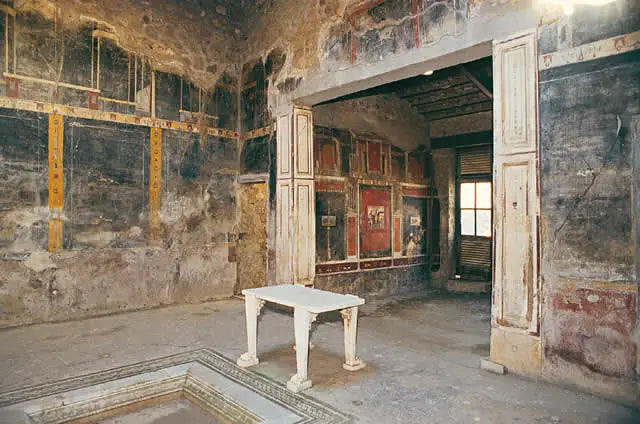
4th century BC. JC: the first office among the Romans
It was in Ancient Rome that the first workspace appeared, in the form of the Tablinum : a room in the Etruscan dwelling serving as the office of the master of the house and as an archive room for documents relating to the status of the family, their magistracies and land activities. Many evidences suggest that these structures constitute the first offices, having a table in the center of the room.
In the 7th century: the scribes of the Middle Ages
It is then with the rise of writing in the Middle Ages that we observe the generalization of workspaces that are the Scriptorium , the office of the monasteries composed of an inclined table, on which the monks carry out their manuscripts. . Although most professional scribes carry out their task from their own home, probably on a desk near a window, this is the first time that we have seen a space specifically dedicated to work outside the home. This configuration extends successively to official buildings and royal palaces for diplomatic activities and the preparation of official documents.

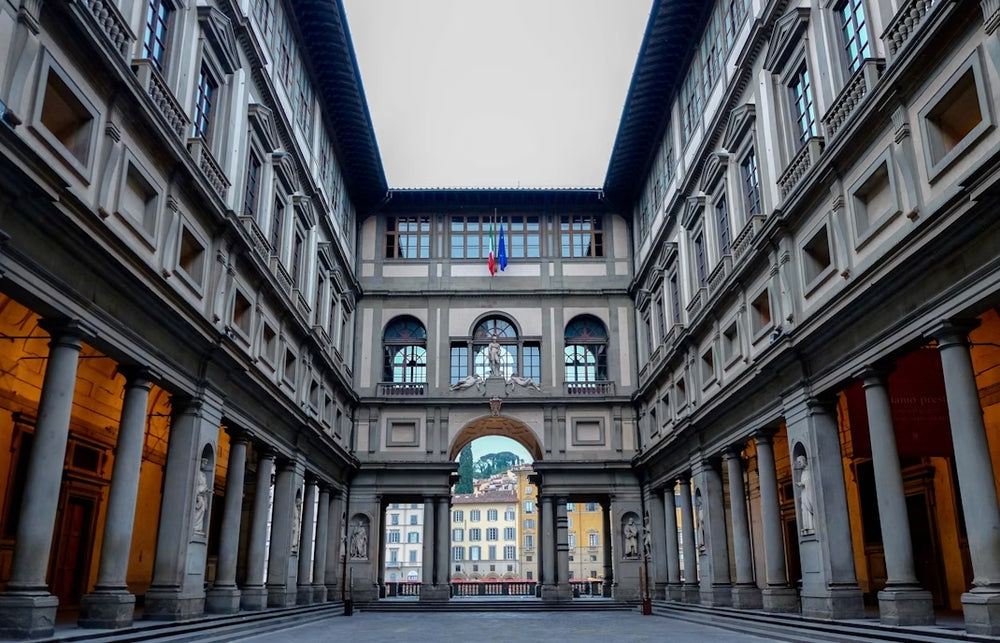
In the 16th century: shared spaces in the Renaissance
We can think that the ancestor of the open space takes place in the workshops of the Renaissance in Italy: open spaces, favoring exchange and creativity, with tables and equipment for working. Humanist artists in particular meet there to discuss new ideas and promote dialogue to build bridges between art and science.
At the same time, the Grand Duchy of Tuscany had a whole new set of offices built for the State administration, the Offices , one of the most famous heritage sites in the world. This is the first time that we see the birth of the concept of centralized offices
The following century, the term "cabinet" conceptualized both the piece of furniture and the room.
The Dictionary of the French Academy of 1684 defines it as follows: "place of retreat to work, or to converse in particular, or to keep papers, books, or something else there, according to the profession or the mood of the person. who lives there”.
In the 18th century: the buildings of the British Empire
The construction of the first buildings continues the centralization of workspaces. With the expansion of the British Empire and the development of trade, the very first building called " The Old Admiralty Office " emerged from the ground in London in 1726. It was placed at the top of the administration of the royal fleet and comprised meeting rooms. The Admiralty board room is still in use today.
There followed a series of constructions of corporate headquarters, the first of which in 1729 was that of the East India Trading Company in Leadenhall Street in order to organize the production process there. The idea is to separate the teams dedicated to "intellectual" work from those dedicated to manual work, which the government formulates in a report:
“For intellectual work, separate rooms are needed so that people working with their heads are not interrupted; and for the more mechanical work, the good mode of organization rests on the grouping of many employees in only one and the same room and coordinated under a qualified director. »
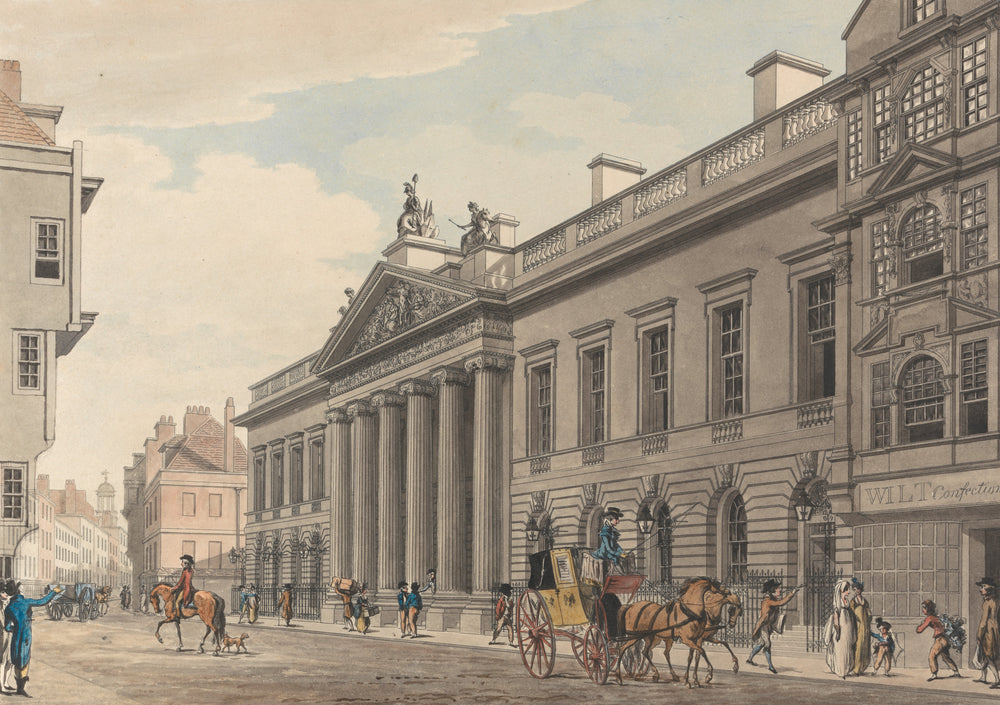
19th century: The emergence of modern offices with the Industrial Revolution
The Industrial Revolution truly marked the birth of offices as we know them today. With the development of the tertiary sector, centralized administrations to facilitate the organization of production processes are becoming widespread. Sociologist and architect Marc Bertier, author of "Open space: between myths and realities" (2016), explains: "Before, we had companies with craftsmen, workers... and the work of processing information was very weak. With industrialization, we will have more and more so-called "support" services, which will create tertiary work. »
XXème siècle : Les immeubles gratte-ciel des États-Unis & le Taylorisme
Dès le début du XXème siècle dans les grandes villes des États-Unis comme New York ou Chicago, les sièges commerciaux sont construits très en hauteur afin d’accueillir de nombreux bureaux plus vastes et plus éclairés. L’invention de l’éclairage électrique, du système de ventilation de l’air et du télégraphe rend possible l’installation de bureaux qui n’ont plus besoin de se situer à proximité directe des usines. Cette architecture permet également d’abriter tous les bureaux dans un seul immeuble.
Dans le même temps, l’open space gagne en popularité en suivant les principes du Taylorisme et son Organisation Scientifique du Travail (OST) : l'organisation horizontale du travail, l'organisation verticale du management, le contrôle du travail et le salaire au rendement. Cela se traduit par une répartition de l’espace inspirée des lignes de montage des usines pour favoriser la division du travail et une productivité accrue, composée de grandes rangées de bureaux ouverts et de plateaux depuis lesquels les directeurs peuvent surveiller,
En 1906, l’inauguration du Larkin Administration Building symbolise le premier ensemble de bureaux modernes avec ses grands plateaux ouverts. L’architecte Frank Lloyd Wright s’est inspiré du gigantisme des cathédrales pour des raisons esthétiques, mais surtout pour répondre au besoin de supervision et de contrôle des employés.
À cette époque, la France reste à l'écart de ce mouvement. "Des immeubles administratifs et des sièges sociaux ont été construits dans la première moitié du XXe siècle, mais la plupart des employés de l'époque travaillaient encore dans des appartements bourgeois reconvertis en bureaux", explique Michael Fenker, directeur scientifique du Laboratoire espaces travail de l'École nationale supérieure d'architecture de Paris-La Villette (ENSAPLV).
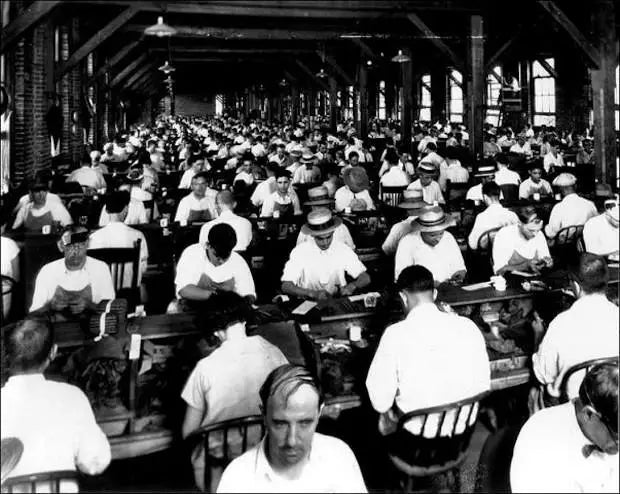
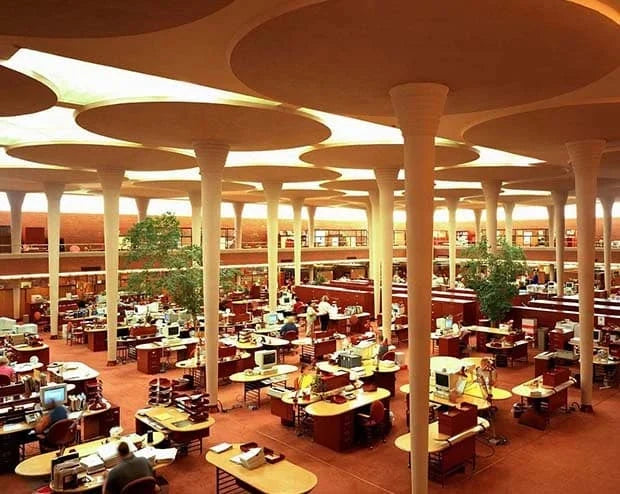
In 1939, the same architect Wright designed the offices of The Johnson Wax: 200 commercial employees were grouped together in a single open space, enriched by new elements such as bright lighting, warm tones, and a cork ceiling covering playing an major in acoustics.
1950s: The “open office” in Germany
The workspace is changing in the aftermath of the Second World War with the adoption of more democratic models and the promotion of human engagement and social interactions.
The brothers Eberhard and Wolfang Schnelle, two German consultants, favor a less rigid and less scientific approach than Taylorism, and highlight the importance of communication within the company. They imagine the Burolandschraft , the first generous spaces, without partitions to promote exchange and collaboration, and many green plants to segment the space in a more natural way. They are also the first to standardize the furniture, which becomes lighter and more comfortable; in a context where sitting comfortably was synonymous with laziness at work and the type of chair was defined according to social status in the company.
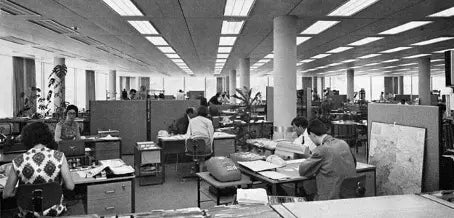
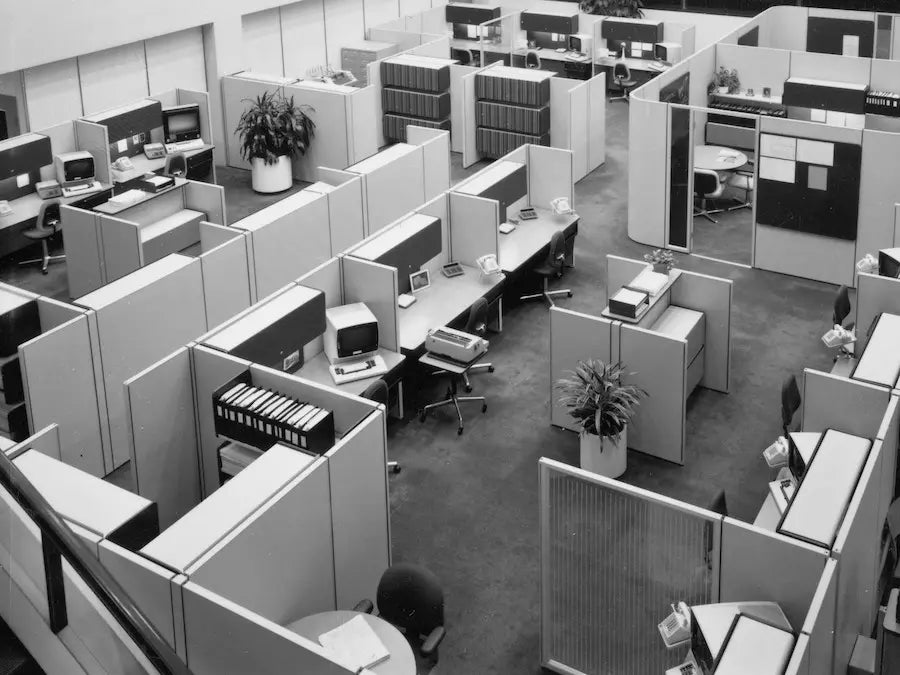
1960s: "The Action Desk" and the "Cubicle"
“The office of action” develops in reaction to the “landscape office” considered as very risky in the United States. These are modular offices made up of panels and workspaces of variable height, capable of adapting to the various activities of employees to facilitate movement and interactions, while protecting the privacy of employees. The spaces are therefore semi-closed with partitions. It was the American company Herman Miller which marketed these first " Action Office Series 1 " in 1964.
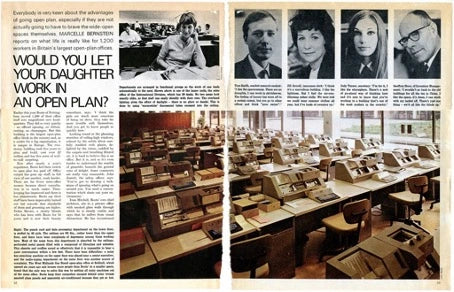
These changes in the organization of space can also be explained by the development of women's work in a long-established male environment, which induces a need for intimacy. These require “a modest tray” to cover the front of the desks and the legs. And for good reason, The Observer headlined an article in 1968 “Would you let your daughter work in an open space? »
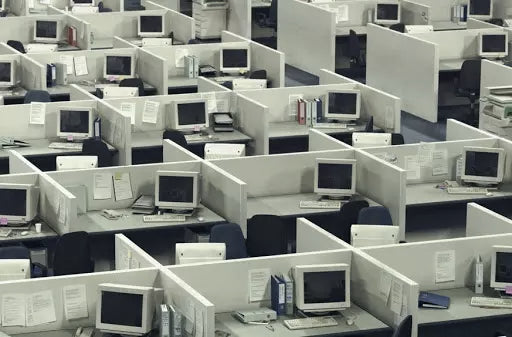
The tertiary sector now representing 50% of the active population, the American designer Robert Probst imagined the "cubicle" in 1968, widely popularized in the 1980s: offices with removable partitions at chest height measuring approximately 1.50 meters, for a sound insulation while providing an overview of standing desks. Allowing managers in particular to monitor employees and sold at a low price, this office format is often associated with deleterious working conditions.
1970s: “Working villages” in Holland
In 1974, the Dutch architect Herman Hertzberger created the Central Beheer Insurance Company , a space designed as a “workers' village”: a multitude of spaces of equal size, duplicated and forming islands connected to each other. They can accommodate groups of up to ten people, encouraged to decorate their workspace themselves with their personal furniture. The aim is to create “the feeling of belonging to a community”.
1980s: The Golden Age of Open Space
Very quickly, the open space seduced by its ability to increase the surface area of workspaces at a lower cost and imposed itself as the model of service companies, banks and insurance firms, extending to small enterprises. Praised for its modern and flexible configuration, ease of movement, access to light, transparency, communication between employees and the flattening of the hierarchy, it became the object of worship and the managerial obsession of the 1980s. .
However, "open space is both the most popular layout for managers and the most contested by employees", notes sociologist Thérèse Evette. It is singled out as an impersonal and standardized space, suppressing intimacy, and a source of numerous noise nuisances, concentration disorders and stress. It generates the feeling of permanent control: “On a set, the employees work permanently under the eye of their colleagues and their bosses. But everyone needs a little shade, a little privacy, a little self-esteem. This self-control exhausts employees and feeds their stress. explains Danièle Linhart, work sociologist at Cresppa-CNRS. Many books testify to this suffering, such as "Open-space killed me" by Alexandre des Isnards or the play "Open Space" by Mathilda May.
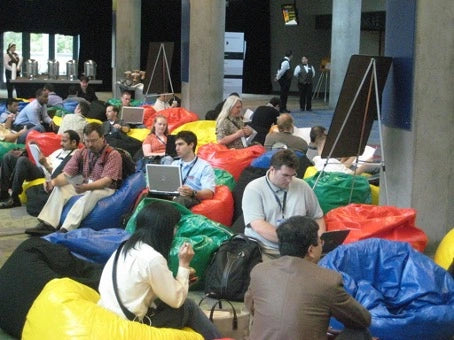
2000s: Towards a relaxed open space
Aware of these limits of open space, companies are trying to move away from a perspective of exclusive profitability of workspaces. The architects introduce elements of leisure and personal decoration in order to make the space pleasant and comfortable. Silicon Valley companies are the first to design warm spaces to promote innovation and serendipity among employees: gardens, cafeteria, fireplace, sports lessons, large soft beanbags, wifi everywhere and possibility to put down your laptop anywhere depending on his mood of the day.
2015: the largest open space in the world
The emblem of this new typology of workspace which aims to be focused on well-being is the MPK20, Facebook's headquarters inaugurated in 2015 in Menlo Park, California: a grandiose area of 40,000 m2 for only 2,800 employees, and 36,000 m2 of garden where they have the opportunity to work in the open air. All services such as laundry or car repair are integrated. The goal is always to "strengthen the spirit of community" through open spaces according to Mark Zuckerberg.
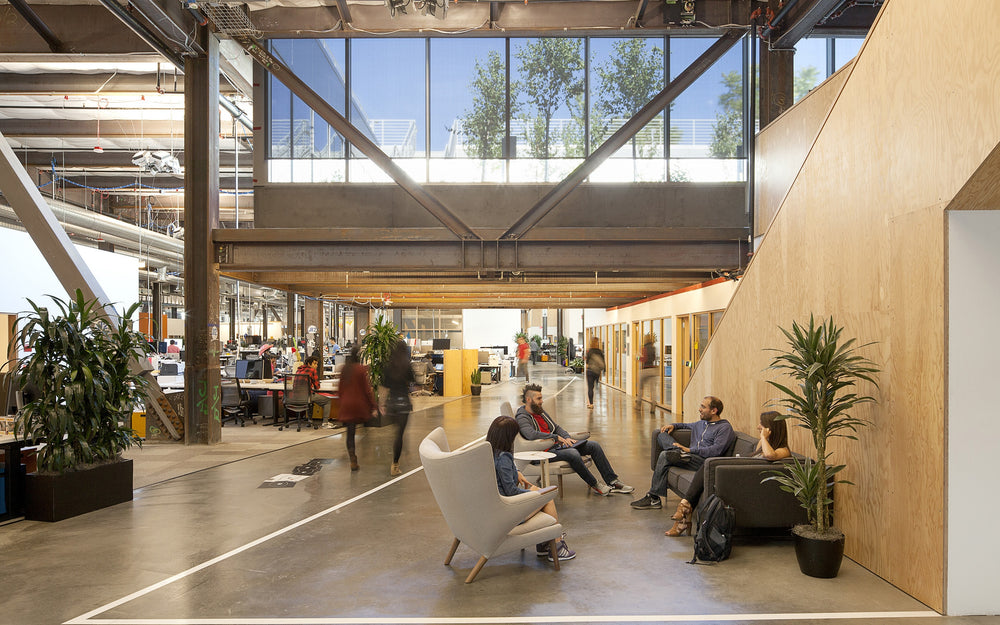
Today: from open space to multi space
The 2020 pandemic has greatly accelerated the adoption of teleworking, sometimes in a constrained way, but has allowed a large number of people to discover serene working conditions that make concentration and freedom of speech possible. The opportunity to work in new places, even outside cities, promotes a break with the work routine. Between employees refusing to return to the office and preferring 100% remote work, those who feel isolated and suffering from telework, new desksharing strategies, flex office , or the emergence of coworking and third places, the Workspace is today undergoing profound change. The salvation of companies will depend on the ability to reinvent itself by taking into account the culture of the company as well as the aspirations of the teams, and to recreate the link at the heart of hybrid organizations.





